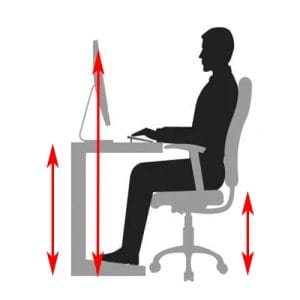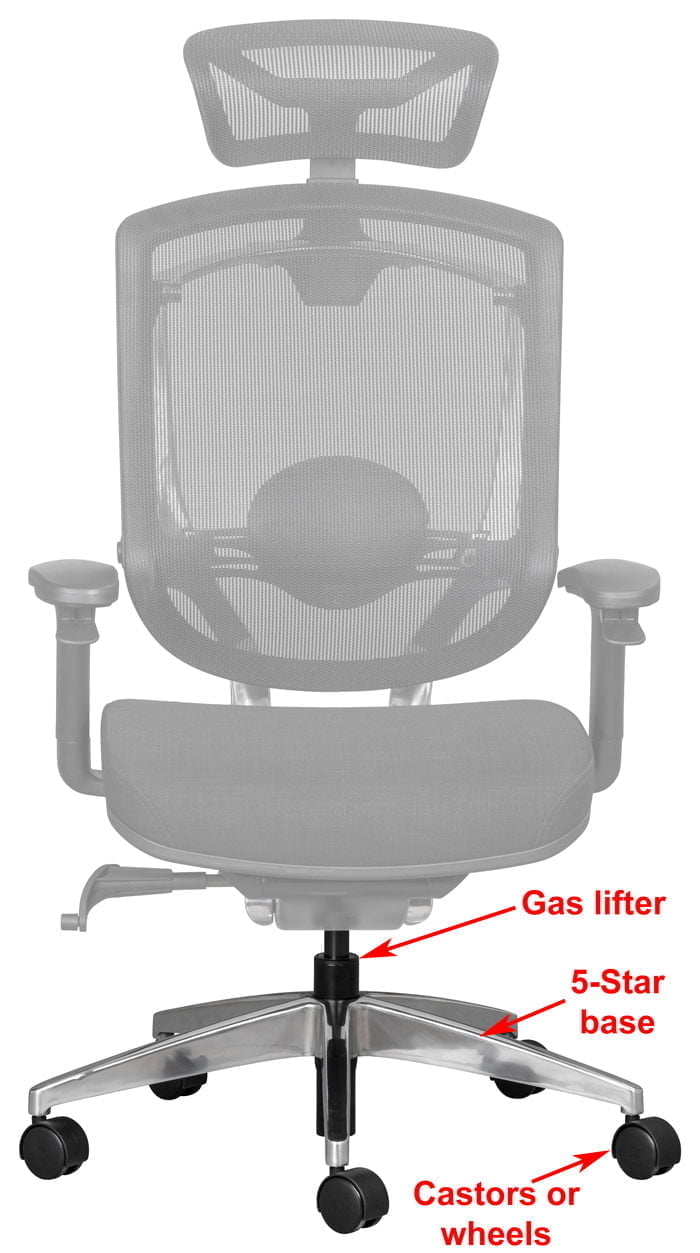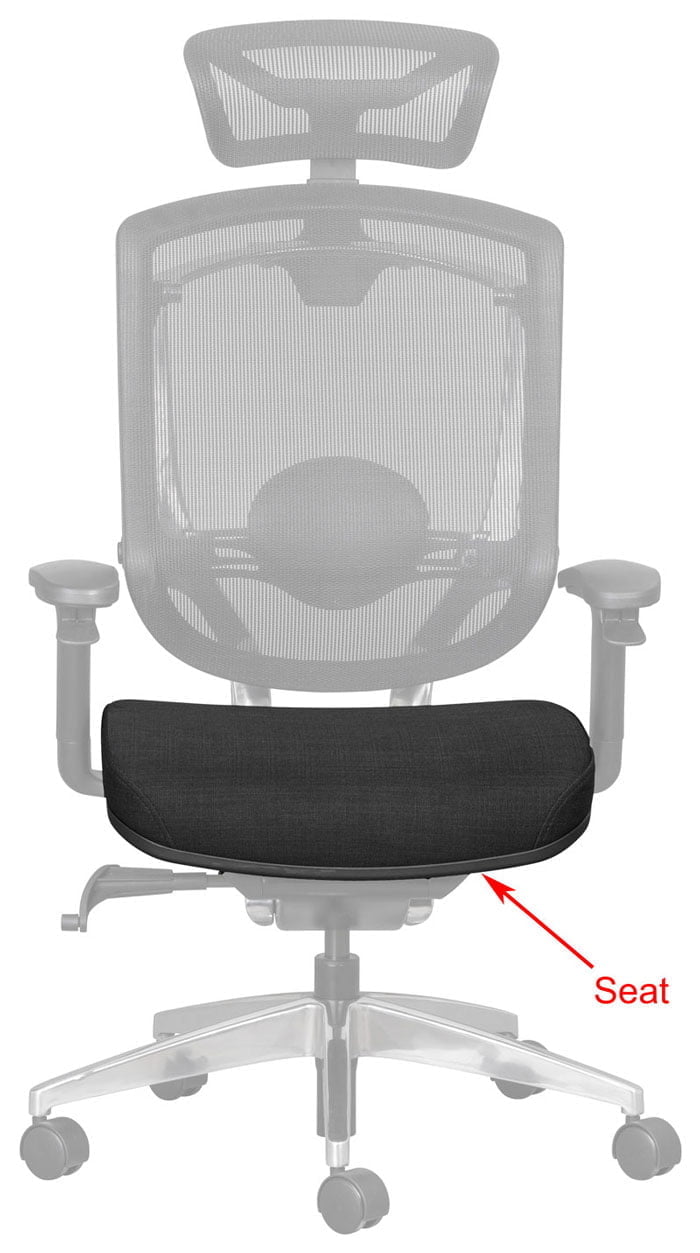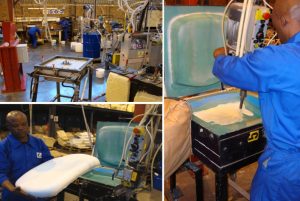
What is the correct ergonomic height for my desk, computer monitor and office chair?
Correct height settings for sitting and standing at work
“Heavy duty office chair” has become a popular search term. Typically these office chairs are used in control rooms and call centres that operate 24/7, as well as for ‘big and tall’ executives. Many office chair retailers sell standard office chairs as “heavy duty”, without providing any real evidence that the chair is in fact a “heavy duty” product. If a standard chair is used in a heavy duty environment, two things usually happen. Either the chair will not perform or last very long, or it may break unexpectedly, possibly causing injury.
Anyone searching for a “heavy duty office chair” would expect it to have superior strength and durability. The Big and Tall Executive would expect the chair to be physically larger and stronger than a conventional office chair.
If you have frequent or chronic back pain, you may need a special solution, namely a heavy duty orthopedic office chair.
To make an office chair “stronger” and “more durable”, its overall design needs to take the higher performance requirements into account. Office Chairs for Individuals above 120kg. The correct combination of ALL the individual components that are required to make up the chair is vitally important. The important components include the following:
This is where the rubber meets the road! For a heavy duty office chair, it is better to have large diameter castors. Larger wheels result in a higher carrying capacity. For example, 60mm diameter castors have a higher carrying capacity than 50mm ones and they are more manoeuvrable. If the chair is used on a hard surface such as a tiled floor, soft rimmed castors are preferable as they won’t damage the floor. Hard castors work fine on a carpeted floor.

5-Star bases are made either from aluminium, glass reinforced nylon, or formed steel tubing.
The gas lifter or actuator, allows you to lift or lower the seat height of the chair. It also acts as a ‘damper’ to cushion the impact when you first sit down. Gas lifters should be manufactured in accordance with a specific international design standard, for example DIN EN 16955-2017. If they are, they will carry the applicable mark or logo as well as a Class Rating. For heavy duty chairs, a Class 4 gas lifter is preferred because it has a higher load rating than the standard Class 3. Gas lifters without this mark may be inferior and may also not support the required weight or load.

The mechanism enables you to adjust the movement of the seat and backrest. Adjustments include the angle of the seat and backrest, the depth of the seat (if a seat slider is fitted), the seat height, and the tilt tension. Office Chairs with Seat Depth Adjustment.
The strength of the office chair mechanism in a heavy duty environment is vital. To ensure that the mechanism is suitable for heavy duty use, it should be strength tested. Organisations such as SABS or BIFMA will conduct tests in accordance with the relevant Product Performance Standards.
Seats for chairs used in a 24/7 environment need to be strengthened to “carry the load”. Normal or standard office chair seats are not designed for a heavy duty application. The chair SEAT consists of 3 major components, namely:
Common materials used for the seat base are plywood, polypropylene or nylon. A seat suitable for a heavy duty chair needs thicker plywood with more laminations. Heavy duty seats made from polypropylene or nylon require additional structural webs or steel reinforcement. The OrthoGrande XXL chair has an extra large seat and backrest to accommodate anyone with a larger frame. Office Chairs for Individuals above 120kg.
Flexible Polyurethane foam is used on all office chair seats, and may be either block cut or moulded. Moulded foam, like that used for a car seat, is more resilient and will last longer. Good quality, high density moulded foam is essential for all heavy duty office chairs. What is the difference between moulded and block-cut foam, and which is best?

Select an upholstery material that suits the operating environment. Polyesther, acrylic or nylon weaves are breathable but more difficult to clean than vinyl or leather. What is the best upholstery fabric for office chairs?
The chair BACKREST consists of 3 major components, namely:

For any office chair, the backrest support structure is not as heavily stressed as the seat. Upholstered plywood backrests do not normally require additional reinforcement, while polypropylene shells typically have standard web reinforcements. If the chair has a mesh backrest, the supporting frame should be made of a good quality, glass fibre reinforced nylon. Other plastics are simply not strong enough for office chairs used in 24/7 control rooms and call centres.
The foam on upholstered office chair backrests is not highly stressed, even in a heavy duty environment. The use of softer, block cut foam is usually adequate.
A good quality mesh will easily have a lifespan of 10+ years. An inferior mesh quickly becomes “saggy” and no longer provides the correct ergonomic support for your back.
Some backrests, like the Heathrow, inherently offer good lumbar support, while others like the Alya and Firefly, have an additional lumbar support adjustment feature. In 24/7 environments where multiple people use the same office chair, you often find that the different users don’t re-adjust the lumbar support when they start their shift. This negates the benefit of the additional lumbar adjustment function. Under such circumstances, a control room or call centre chair like the Heathrow is worth considering.
Height adjustable armrests are an ergonomic essential for all office chairs used in a 24/7 control room or call centre.

What are the different types of armrests available for office chairs, and which is best?
Depending on the work performed, height adjustable armrests can add to the ergonomic benefit. Some chairs have multi-functional armrests. These are height and width adjustable, and also allow the arm pads to be moved forwards, backwards and even swivel inwards and outwards.
Armrests for Big and Tall executive office chairs should be strengthened as they are often used to assist the user to get into and out of the chair. For example, on the Heathrow chair, the armrests are attached to the seat that has a 12 lamination (18mm), plywood seat shell. The Heathrow has 3 different arm options depending on the individual strength requirements.
Headrests are optional items. If the chair is used by more than one person, the headrest should preferably not be upholstered in fabric as it is more difficult to clean between operators.
If a standard office chair is used in a heavy duty environment, two things typically happen. Either the chair will not perform or last very long, or it may break unexpectedly resulting in injury.
Heavy duty chairs need to be strengthened so that they are able to withstand the rigors of a 24/7 operating environment. Big and tall executives expect their office chair to be physically larger and stronger. The critical items that need additional strength include the base set, seat, mechanism and armrest attachment.

Correct height settings for sitting and standing at work

At Karo, we improve the comfort of our chairs by including moulded foam in the design of all our seats.

Office chairs fitted with either a Free-Float or Synchronous mechanism encourage Dynamic Sitting which is crucial for improved ergonomic comfort.


